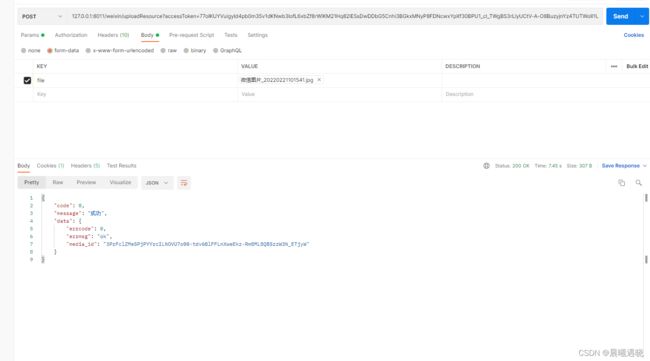企业微信上传临时素材文件
1.控制层
/**
* 上传临时素材
*/
@ResponseBody
@PostMapping("/uploadResource")
public BaseResponse uploadResource(MultipartHttpServletRequest param,@RequestParam("accessToken") String token,@RequestParam("type")String type) throws Exception{
return BaseResponse.Builder.build(weixinService.uploadResource(param,token,type));
}2.Service层
/**
* 上传临时素材
* @param param
* @return
*/
Map uploadResource(MultipartHttpServletRequest param,String accessToken,String type)throws Exception ; 3.实现层
@Override
public Map uploadResource(MultipartHttpServletRequest param,String accessToken,String type)throws Exception {
/**
* 1.封装Multipart参数
*/
MultipartFile file = param.getFile("file");
/**
* 2.调用上传临时素材接口
*/
String result = uploadFile(M2F(file), type, accessToken);
log.info("getMessageResult result=" + result);
/**
* 3.返回上传临时素材接口响应数据
*/
Map map=new HashMap<>();
JSONObject resultObject = new JSONObject(result);
map.put("errcode",resultObject.getInt("errcode"));
map.put("errmsg",resultObject.get("errmsg"));
map.put("media_id",resultObject.get("media_id"));
return map;
}
/**
* MultipartFile文件转File文件
* @param file
* @return
* @throws Exception
*/
public File M2F(MultipartFile file) throws Exception {
File f=File.createTempFile(UUID.randomUUID().toString(), "." + FilenameUtils.getExtension(file.getOriginalFilename()));
file.transferTo(f);
return f;
}
/**
* 处理请求数据
* @param file
* @param fileType
* @param accessToken
* @return
*/
public String uploadFile(File file, String fileType,String accessToken){
RestTemplate restTemplate = new RestTemplate(new HttpsClientRequestFactory());
String url = "https://qyapi.weixin.qq.com/cgi-bin/media/upload?access_token="+accessToken+"&type="+fileType;
HttpHeaders headers = new HttpHeaders();
MediaType type = MediaType.parseMediaType("multipart/form-data");
headers.setContentType(type);
headers.setContentLength(file.length());
headers.setContentDispositionFormData("media",file.getName());
MultiValueMap param = new LinkedMultiValueMap<>();
FileSystemResource resource = new FileSystemResource(file.getPath());
param.add("file",resource);
HttpEntity> formEntity = new HttpEntity<>(param, headers);
ResponseEntity data = restTemplate.postForEntity(url,formEntity,String.class);
String body = data.getBody();
return body;
}
4.HttpClient类
import org.springframework.http.client.SimpleClientHttpRequestFactory;
import javax.net.ssl.HostnameVerifier;
import javax.net.ssl.HttpsURLConnection;
import javax.net.ssl.SSLContext;
import javax.net.ssl.SSLSession;
import javax.net.ssl.SSLSocket;
import javax.net.ssl.SSLSocketFactory;
import javax.net.ssl.TrustManager;
import javax.net.ssl.X509TrustManager;
import java.io.IOException;
import java.net.HttpURLConnection;
import java.net.InetAddress;
import java.net.Socket;
import java.security.cert.CertificateException;
import java.security.cert.X509Certificate;
/**
* @author fcx
* @create 2022-04-15 10:37
**/
public class HttpsClientRequestFactory extends SimpleClientHttpRequestFactory {
@Override
protected void prepareConnection(HttpURLConnection connection, String httpMethod) {
try {
if (!(connection instanceof HttpsURLConnection)) {
throw new RuntimeException("An instance of HttpsURLConnection is expected");
}
HttpsURLConnection httpsConnection = (HttpsURLConnection) connection;
TrustManager[] trustAllCerts = new TrustManager[]{
new X509TrustManager() {
@Override
public void checkClientTrusted(X509Certificate[] x509Certificates, String s) throws CertificateException {
}
@Override
public void checkServerTrusted(X509Certificate[] x509Certificates, String s) throws
CertificateException {
}
@Override
public X509Certificate[] getAcceptedIssuers() {
return null;
}
}
};
SSLContext sslContext = SSLContext.getInstance("TLS");
sslContext.init(null, trustAllCerts, new java.security.SecureRandom());
httpsConnection.setSSLSocketFactory(new MyCustomSSLSocketFactory(sslContext.getSocketFactory()));
httpsConnection.setHostnameVerifier(new HostnameVerifier() {
@Override
public boolean verify(String s, SSLSession sslSession) {
return true;
}
});
super.prepareConnection(httpsConnection, httpMethod);
} catch (Exception e) {
e.printStackTrace();
}
}
/**
* We need to invoke sslSocket.setEnabledProtocols(new String[] {"SSLv3"});
* see http://www.oracle.com/technetwork/java/javase/documentation/cve-2014-3566-2342133.html (Java 8 section)
*/
// SSLSocketFactory用于创建 SSLSockets
private static class MyCustomSSLSocketFactory extends SSLSocketFactory {
private final SSLSocketFactory delegate;
public MyCustomSSLSocketFactory(SSLSocketFactory delegate) {
this.delegate = delegate;
}
// 返回默认启用的密码套件。除非一个列表启用,对SSL连接的握手会使用这些密码套件。
// 这些默认的服务的最低质量要求保密保护和服务器身份验证
@Override
public String[] getDefaultCipherSuites() {
return delegate.getDefaultCipherSuites();
}
// 返回的密码套件可用于SSL连接启用的名字
@Override
public String[] getSupportedCipherSuites() {
return delegate.getSupportedCipherSuites();
}
@Override
public Socket createSocket(final Socket socket, final String host, final int port,
final boolean autoClose) throws IOException {
final Socket underlyingSocket = delegate.createSocket(socket, host, port, autoClose);
return overrideProtocol(underlyingSocket);
}
@Override
public Socket createSocket(final String host, final int port) throws IOException {
final Socket underlyingSocket = delegate.createSocket(host, port);
return overrideProtocol(underlyingSocket);
}
@Override
public Socket createSocket(final String host, final int port, final InetAddress localAddress,
final int localPort) throws
IOException {
final Socket underlyingSocket = delegate.createSocket(host, port, localAddress, localPort);
return overrideProtocol(underlyingSocket);
}
@Override
public Socket createSocket(final InetAddress host, final int port) throws IOException {
final Socket underlyingSocket = delegate.createSocket(host, port);
return overrideProtocol(underlyingSocket);
}
@Override
public Socket createSocket(final InetAddress host, final int port, final InetAddress localAddress,
final int localPort) throws
IOException {
final Socket underlyingSocket = delegate.createSocket(host, port, localAddress, localPort);
return overrideProtocol(underlyingSocket);
}
private Socket overrideProtocol(final Socket socket) {
if (!(socket instanceof SSLSocket)) {
throw new RuntimeException("An instance of SSLSocket is expected");
}
((SSLSocket) socket).setEnabledProtocols(new String[]{"TLSv1"});
return socket;
}
}
}如果在调用的时候出现了javax.net.ssl.SSLHandshakeException: No appropriate protocol (protocol is disabled or cipher suites are inappropriate)异常 需要配置JM的参数设置,经过百度查询
原因: 配置文件中禁用 TLSv1, TLSv1.1
修改如下:
把..\Java\jdk-11.0.11\conf\security文件下的java.security文件
将 :
jdk.tls.disabledAlgorithms=SSLv3, TLSv1, TLSv1.1, RC4, DES, MD5withRSA, \
DH keySize < 1024, EC keySize < 224, 3DES_EDE_CBC, anon, NULL, \
include jdk.disabled.namedCurves
替换为:
jdk.tls.disabledAlgorithms=SSLv3, RC4, DES, MD5withRSA, \
DH keySize < 1024, EC keySize < 224, 3DES_EDE_CBC, anon, NULL, \
include jdk.disabled.namedCurves
测试post:
